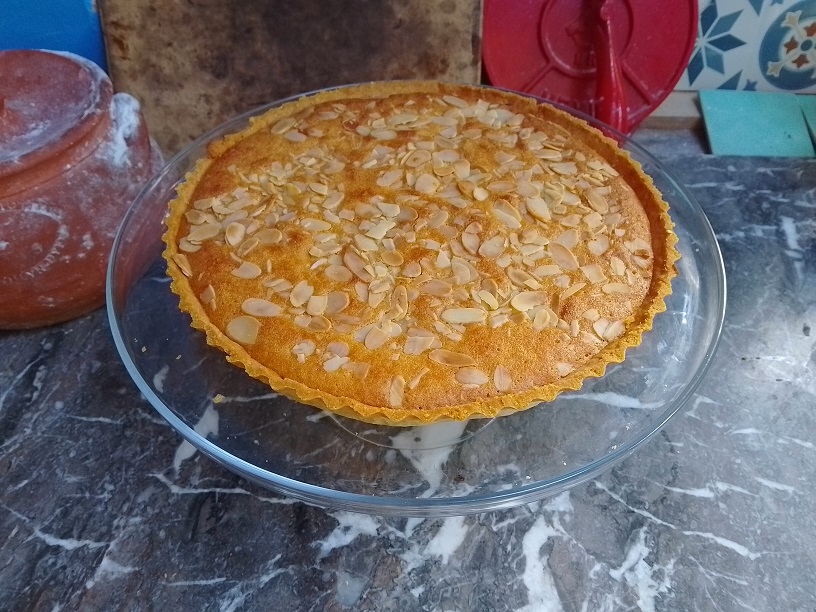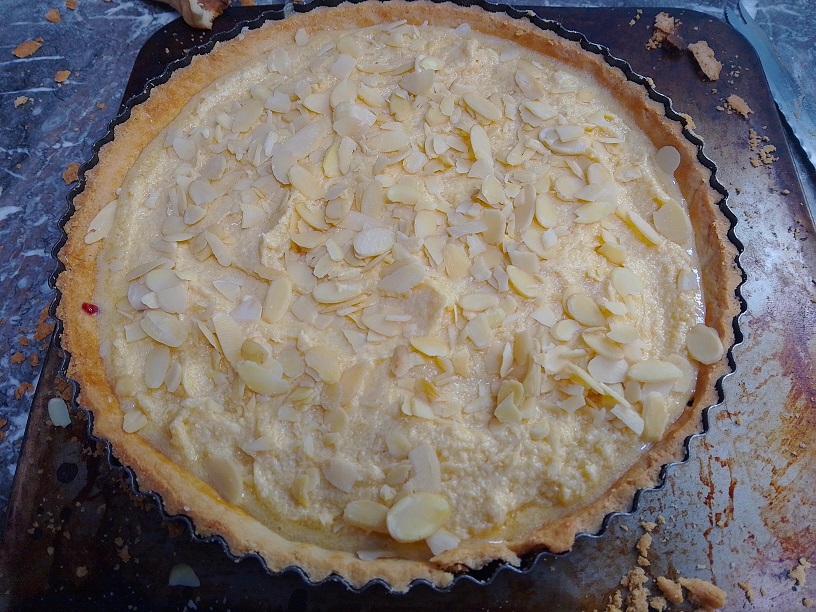
A friend asked for the recipe for my bakewell tart filling, after seeing the finished bakewell tart I made in my shortcrust pastry recipe, so here it is! Bakewell tart is one of my favourite tarts—it consists of a pastry case filled with a layer of jam on the bottom and a thick layer of baked frangipane (a sweet almond paste) on top. Some versions of it coat the top with feathered icing, but I personally think this is gilding the lily somewhat—the frangipane filling is rich enough, in my book.

If you don’t have access to ground almonds, you can make your own, if you have a food processor or blender, from whole almonds or flaked almonds—make sure the almonds are blanched (skinless), and pulse them in the food processor until they’re of a fine consistency, but not smooth (you don’t want to make almond butter).
I use salted butter, and as such I usually leave out the pinch of salt in the ingredients list—you can use salted or unsalted butter, according to your preference. You want the butter to be soft and pliable—do not use butter right out of the fridge!
Caster sugar is preferred, as it makes for a smoother consistency when creaming together the butter and sugar. You could use golden caster sugar, but brown sugar wouldn’t suit the flavour of a bakewell tart.
I use medium hen's eggs—you don’t need to be too precise with the size.
Almond extract lends the Bakewell’s filling that distinct marzipany flavour—you could still make a nice tart without it, but something will be missing, in my opinion. In the UK, “extract” and “essence” are different things—essence can be purely artificial (meaning “almond essence” may not have any actual almond content) and so extract is preferable.
Just plain table salt.
You can buy them toasted or untoasted, it doesn’t really matter.
Raspberry jam is the traditional jam for Bakewell tart—cherry or apricot jam would probably work quite well too. You don't need to be too precise with the amount—simply use enough to cover the bottom.
If you do not have a convection oven, raise the temperature to 180 C.
I cream butter and sugar in my food processor—simply put both the sugar and the butter into the food processor compartment, then process the mixture on the highest speed until it is fully combined and light in colour. To cream butter and sugar by hand, press a wooden spoon against the butter and sugar mixture and smear it against the side of the bowl, repeating until the mixture comes together into a loose, light paste. If the butter is cold (either from the fridge or a cold kitchen), this can initially be quite strenuous work—hence why I use the food processor to do the job for me.
If using a food processor, just add the eggs and almond extract into the food processor compartment, then process until it comes together—you might need to stop every so often to scrape the creamed butter and sugar mixture off the bottom, to ensure that everything is mixed together. If doing this step by hand, use the spoon to mix the eggs and extract in initially, then switch to a whisk or fork and beat the mixture until well-combined.
I pour the almonds into the food processor, process it until it forms into a rough mixture, then return the mixture to a bowl before finishing mixing it with a silicon spatula. Otherwise, just mix the ground almonds into the butter/sugar/egg mixture by hand, using either a wooden spoon or spatula. It will be done when everything looks combined.
Spoon out the jam onto the bottom of the pastry case, then gently spread it until you have an even coverage of the entire surface. Do be gentle—you don’t want to break the pastry. If the jam is stiff (sometimes an occurrence for my homemade jams), then briefly submerge the jar in a bowl of boiled water, or microwave the jar (having removed any metal lids, etc of course) on a low setting, until the jam is loose.


I pour the filling into the pastry case in small chunks, using a wooden spoon for the purpose, starting from the edge of the pastry case and working my way inwards, in order to avoid the weight of the mixture pushing all the jam to the sides of the case. Once you’ve placed all the filling into the case, smooth it out with the back of a metal spoon or the flat of a palette knife, in order to ensure an even coverage.
The flaked almonds add a nice textural contrast, alongside looking pretty—you could toast them to bring out their flavour beforehand (or buy pretoasted flaked almonds), if you like, but I don’t think it’s necessary for this dish as they will be exposed to the heat of the oven as the tart bakes anyway.
The time is just a guideline—what you want is a filling which has cooked all the way into the centre, and browned nicely on top. You will know if it is cooked all the way into the centre if a knife inserted into the filling comes out mostly clean of batter—though I mostly just go by intuition, since a knife mark on the top would look unappealing. Really, forty minutes is more than enough to bake it all the way through.